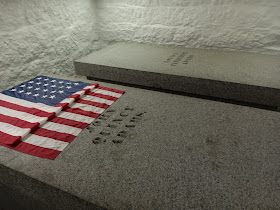Yesterday I provided some insight into John and Abigail Adams, since we were visiting the Church of the Presidents in Quincy, Massachusetts. Their son John Quincy Adams, the 6th U.S. President, and his wife Louisa are also interred in the crypt of the church. So today's blog will provide a little background about them, courtesy of the Mass. Historical Society AND how the tension between Louisa and her mother-in-law came to an end! (I needed something gossipy to keep your attention). Read on!
(Photo: Tom and Rob in the Church of the Presidents, learning about John Quincy and Louisa Catherine Adams. Credit: R.G.)
WHO WAS JOHN QUINCY ADAMS? He was the eldest son of John and Abigail (Smith) Adams was born 11 July 1767. As a young boy Adams accompanied his father on his diplomatic missions to Europe. He attended school at a private academy outside Paris, the Latin School of Amsterdam, and Leyden University. In 1781–1782 he was in St. Petersburg as private secretary and interpreter to U.S. minister to Russia. In 1785 Adams returned to the U.S. to continue his formal education. He graduated from Harvard College in 1787, studied law for three years then practiced law in Boston.
ENTRY INTO POLITICS - In 1794 President Washington appointed him minister to the Netherlands. Adams served one year in the Massachusetts State Senate and in April 1803 was appointed to fill an unexpired seat in the U.S. Senate. His independent actions in the Senate, namely support for the Louisiana Purchase and the Embargo of 1807, quickly alienated him from the Federalist party in Massachusetts. He later spent five years in Russia.

(Photo: John Quincy and Louisa Catherine Adams)
Months after the U.S. declaration of war against Great Britain in 1812, John Quincy Adams was involved in efforts to bring about peace—first through Russian mediation and later as a negotiator at Ghent in 1814.
The Adamses’ stay in Europe was extended when John Quincy was appointed minister plenipotentiary to Great Britain (1815). He returned to the U.S. in 1817. Significant among his many accomplishments are the negotiation of the Transcontinental Treaty of 1819 with Spain, the completion of his authoritative Report on Weights and Measures(1821), and the development of the Monroe Doctrine (1823).
ADAMS AS PRESIDENT - Adams’ one term as president was not so successful. Although he ran second to Andrew Jackson in the 1824 election, he was chosen president by the U.S. House of Representatives when no candidate received a majority vote by the electoral college. After losing a second term, Adams served in Congress from 1831 to 1848. He became an increasingly vocal opponent of slavery and its expansion. He died on Feb 23, 1848.
WAS THERE TENSION BETWEEN ABIGAIL ADAMS AND LOUISA? - Our tour guide explained that there was indeed some tension between John Quincy Adams' wife Louisa and her mother-in-law, Abigail. That is, until Abigail learned a few things. First, both women lost a baby daughter at 13 months old. Second, when Louisa was visiting Russia and took a carriage ride to France to meet her husband, she encountered some French thieves who hated Russians. Thinking she was Russian, they threatened her with death, but she was fluent in French and convinced them she was related to Napoleon- so they let her go!
(Photo: The pulpit in the Church of Presidents. It was made of Domenican Mahogany! Credit: R.G.)
WHO WAS LOUISA CATHERINE (JOHNSON) ADAMS? The Massachusetts Historical Society noted that the wife of John Quincy Adams was born in London on 12 February 1775. From 1778 to 1783, while England and France were at war, the Johnson family lived in Nantes, France, and she learned to speak French fluently. The family returned to London in 1790.
Louisa and John Quincy Adams became engaged in 1796 when the latter, then U.S. minister to the Netherlands, was in London for the ratification of Jay’s Treaty and were married in that city on 26 July 1797, in the parish church of All Hallows Barking.
Louisa accompanied her husband on his diplomatic assignments to Berlin (1797–1801), St. Petersburg (1809–1815), and London (1815–1817). When John Quincy’s career called the couple to Washington the Adamses lived at first (1803–1808) with Louisa’s family, who had settled there following the collapse of Joshua Johnson’s London business in 1797.
During their later residence at the Capitol the Adamses' social life was particularly demanding. Louisa hosted weekly receptions at their home on F Street, Washington, DC, when John Quincy Adams was secretary of state and presided at dinners and levees in the White House when first lady. Louisa stayed on at the F Street residence following John Quincy’s death in 1848. She suffered a stroke the following year and died on 15 May 1852.
NEXT: Down into the Crypts!













































